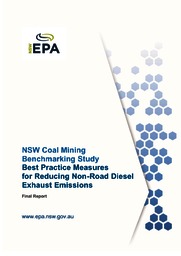NSW Coal Mining Benchmarking Study
The EPA
- reviewed operational details and practices used at the 64 EPA-licensed coal mines in 2013
- reviewed international best practice measures to reduce non-road diesel emissions and compared these with those used in each NSW coal mine
- estimated the costs and benefits associated with adopting best practice at each coal mine
- published a draft report and consulted with stakeholders, including industry, environmental, local government and community groups, from December 2014 to February 2015.
Seven stakeholder submissions were received on the draft report, mostly supporting its recommendations to
- adopt US Tier 4 emission standards for new equipment (additional or replacement non-road diesels)
- provide a flexible range of options for reducing emissions from existing equipment
- develop procedures to certify and verify emission reduction technologies for in-service, new and replacement non-road diesel equipment and vehicles.
Final report recommendations
The final report, NSW Coal Mining Benchmarking Study - Best Practice Measures for Reducing Non-Road Diesel Exhaust Emissions (PDF 4MB) evaluates options for reducing fine particulate emissions at NSW coal mines raised in the draft report, which include
- retrofitting exhaust after treatment equipment
- in-cylinder combustion optimisation and other engine modifications
- repowering equipment with engines that have a higher Tier certification or are certified to produce lower levels of particulate matter emissions
- alternative low-emission fuels or fuel additives
- combining various technologies such as using B20 with diesel oxidation catalyst and engine optimisation, and emulsified biodiesel blends
The report also
- identifies cost-effective options to reduce non-road diesel emissions
- recommends that coal mines conduct a best management practice (BMP) determination to identify the most practical options for reducing exhaust emissions
- details the performance standards, implementation timeframes, certification and verification requirements for in-service, new and replacement non-road diesel vehicles and equipment
- incorporates stakeholder feedback.
The report recommends
- for existing EPA-licensed coal mines, implementing BMP through a pollution reduction program enforced through environment protection licence conditions
- for proposed NSW coal mine developments, BMP should form part of the environmental assessment, which is directly linked to the air quality impact assessment.
Next steps
The EPA is engaging with stakeholders and seeking feedback on the proposed pollution reduction program for non-road diesel vehicles and equipment at EPA-licensed coal mines.


